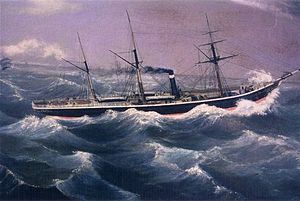SS Admella

SS Admella in a heavy sea
|
|
| History | |
|---|---|
|
|
|
| Name: | SS Admella |
| Owner: | Robert Little and 7 others |
| Route: | Adelaide–Melbourne–Launceston |
| Builder: |
|
| Cost: | £15,000 |
| Launched: | 17 September 1857 |
| In service: | March 1858 |
| Fate: | Wrecked off Carpenter Rocks, South Australia on 6 August 1859 |
| General characteristics | |
| Class and type: | Steamship |
| Tonnage: | 395 GT |
| Length: | 60 m (200 ft) |
| Beam: | 8 m (26 ft) |
| Depth: | 4.2 m (14 ft) |
| Installed power: | twin 100 hp (75 kW) steam engines |
| Propulsion: | Steamer Screw |
| Sail plan: | Three sails |
| Speed: | 17 knots (31 km/h) |
| Capacity: | 113 |
| Crew: | 29 |
SS Admella was an Australian passenger steamship that was shipwrecked on a submerged reef off the coast of Carpenter Rocks, south west of Mount Gambier South Australia, in the early hours of Saturday 6 August 1859. Survivors clung to the wreck for over a week and many people took days to die as they glimpsed the land from the sea and watched as one rescue attempt after another failed.
With the loss of 89 lives, mostly due to cold and exposure, it is one of the worst maritime disasters in Australian history. Admella disaster remains the greatest loss of life in the history of European settlement in South Australia. Of the 113 on board 24 survived, including only one woman, Bridget Ledwith. Of the 89 dead, 14 were children. The 150th anniversary of the disaster was marked in August 2009 by events across the south east of South Australia and at Portland, Victoria.
SS Admella (so named for her circuit Adelaide, Melbourne, Launceston) was built by Lawrence Hill and Co. at Port Glasgow, Scotland in 1857. She was an iron single screw steamer nearly 60 metres long and 8 metres at her widest and displaced about 395 tons. At the time she was one of the fastest and most luxurious ships on the Australian intercolonial trade routes. On the regular Adelaide – Melbourne run her fastest voyage had once been made in 42 hours.
In 39 voyages between Adelaide and Melbourne there had never been cause for alarm aboard Admella. Never any need for life boats or life belts. The vessel's only captain, Hugh McEwan was a cautious and capable master mariner. Admella had been built with watertight bulkheads, riveted to the hull. These were designed as a special safety feature, but were ultimately the cause of a catastrophic break up of the ship into three exposed sections in the first 15 minutes of the disaster.
Under the command of Captain Hugh McEwan Admella left Port Adelaide for what was to be her final trip early on Friday, 5 August 1859, on her usual run to Melbourne with 84 passengers and 29 crew. Her cargo consisted of 93 tons of copper, flour for the Victorian goldfields, general merchandise, and four racehorses. Due to the heavy swell, one of the horses fell over. To right it the ship changed course slightly, while the horse was put on its feet.
At four o'clock next morning, when the vessel was approaching the Cape Northumberland light, the captain believed himself to be far from land. In reality, however, the ship was close to a dangerous reef at 37°52′47″S 140°21′3″E / 37.87972°S 140.35083°ECoordinates: 37°52′47″S 140°21′3″E / 37.87972°S 140.35083°E, probably from a current that carried the vessel shorewards.
...
Wikipedia
